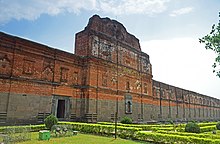Ilyās Shāhī
| |
|---|---|
| Royal house | |
| Country | Bengal Sultanate |
| Current region | Bengal |
| Etymology | Name of Ilyas Shah |
| Place of origin |
Sistan Bengali (from 1438) |
| Founded | 1342 |
| Founder | Shamsuddin Ilyas Shah |
| Final ruler | Jalaluddin Fateh Shah |
| Titles | Sultan |
| Connected members | Shihabuddin Bayazid (slave) |
| Traditions | Sunni Islam |
| Estate(s) |
Satgaon (from 1338) Hazrat Pandua (from 1352) Gaur (from 1450) |
| Dissolution | 1487 |
| Deposition | 1415 and 1487 |
The Ilyas Shahi dynasty ( Bengali: ইলিয়াস শাহী খান্দান, Persian: دودمان الیاسشاهی) was the first independent dynasty to set the foundations of the late medieval Sunni Muslim Sultanate of Bengal. Hailing from the Sistan region, [1] [2] [3] their rule extended from 1342 to 1487, though interrupted with an interregna by their slaves as well as the House of Ganesha. [4]
Initial dynasty

The ancestors of Ilyas Shah originated from Sistan, and according to Syed A M R Haque, arrived to the subcontinent as Muslim missionaries and the family were granted jagirs in Bengal in the year 1227. Bengal was under the Delhi Sultanate at the time.
During the governorship of Izz al-Din Yahya in Satgaon, Shamsuddin Ilyas Shah took service under him. Following Yahya's death in 1338, Ilyas Shah took control of Satgaon and declared himself as a Sultan, independent of Delhi. He then waged a campaign, defeating both the Sultans Alauddin Ali Shah and Ikhtiyaruddin Ghazi Shah of Lakhnauti and Sonargaon respectively by 1342. This led to the foundation of Bengal as single political entity and the start of the Bengal Sultanate and its first dynasty, the Ilyas Shahi.
After Shamsuddin's death, his son Sikandar Shah ascended the throne. Sikandar ruled for the next 30 years and built the Adina Masjid in Pandua in 1368 and Kotwali Darwaza in Gauḍa. Ghiyasuddin Azam Shah, son of Sikandar Shah succeeded the throne and established friendly relationships with the Ming Empire of China and encouraged trade. During his reign, Ma Huan, a Chinese traveller visited Bengal.
Instability
In 1415, political confusion and weakness of the Ilyas Shahi dynasty led to Saifuddin Hamza Shah's rule being overthrown by slave Shihabuddin Bayazid Shah's family and the House of Ganesha shortly after. [5] Ganesha's son Jadu embraced Islam and assumed the title of Jalal ad-Din Muhammad Shah. He was succeeded by his son, Shams ad-Din Ahmad Shah. Ahmad was killed by his nobles in 1436 in an attempt to restore the Ilyas Shahi dynasty.
Restored dynasty
After the death of Shams ad-Din Ahmad, the rule of the Ilyas Shahi dynasty was restored by Mahmud Shah, a descendant of Shamsuddin Ilyas Shah, who ascended the throne in 1437 as Nasiruddin Mahmud Shah I. In 1487, the last ruler of this dynasty Jalal ad-Din Fatih Shah was killed by his Habshi commander of the palace guards, Shahzada Barbak, who ascended the throne under the title, Sultan Barbak Shah. With this, the Ilyas Shahi dynasty's rule over Bengal came to an end. [6] The current
List of rulers
| Titular Name(s) | Personal Name | Reign | |
|---|---|---|---|
| Sultan Shams ad-Din سلطان شمس الدين Bengali: সুলতান শামসউদ্দীন |
Ilyas Shah إلياس شاه Bengali: ইলিয়াস শাহ |
1342–1358 | |
| Sultan Abu al-Mujahid سلطان أبو المجاحد Bengali: সুলতান আবুল মুজাহ্বিদ |
Sikandar Shah سكندر شاه Bengali: সিকান্দর শাহ |
1358–1390 | |
| Sultan Ghiyath ad-Din سلطان غياث الدين Bengali: সুলতান গিয়াসউদ্দীন |
Azam Shah أعظم شاه Bengali: আজ়ম শাহ |
1390–1411 | |
| Sultan Sayf ad-Din سلطان سيف الدين Bengali: সুলতান সাইফউদ্দীন |
Hamzah Shah حمزة شاه Bengali: হামজ়া শাহ |
1411–1413 | |
| Sultan Abu al-Muzaffar سلطان أبو المظفر Bengali: সুলতান আবুল মুজ়াফফর |
Muhammad Shah محمد شاه Bengali: মোহাম্মদ শাহ |
1413 | |
| Sultan Nasir ad-Din Abu al-Muzaffar سلطان ناصر الدین أبو المظفر Bengali: সুলতান নাসিরউদ্দীন আবুল মোজ়াফ্ফর |
Mahmud Shah محمود شاه Bengali: মাহমূদ শাহ |
1435–1459 | |
| Sultan Rukun ad-Din سلطان ركن الدين Bengali: সুলতান রোকনউদ্দীন |
Barbak Shah باربک شاه Bengali: বারবক শাহ |
1459–1474 | |
| Sultan Shams ad-Din Abu al-Muzaffar سلطان شمس الدین أبو المظفر Bengali: সুলতান শামসউদ্দীন আবুল মোজ়াফ্ফর |
Yusuf Shah يوسف شاه Bengali: ইউসুফ শাহ |
1474–1481 | |
| Sultan Nur ad-Din سلطان نور الدین Bengali: সুলতান নূরউদ্দীন |
Sikandar Shah سکندر شاه Bengali: সিকান্দর শাহ |
1481 | |
| Sultan Jalal ad-Din سلطان جلال الدين Bengali: সুলতান জালালউদ্দীন |
Fateh Shah فتح شاه Bengali: ফতেহ শাহ |
1481–1487 | |
| Habshi rule takes over Sultanate of Bengal under Shahzada Barbak in 1487 C.E. | |||
- Silver shaded row signifies the start of the Restored Ilyas Shahi dynasty.
See also
References
- ^ André Wink (2003). Indo-Islamic society: 14th – 15th centuries. BRILL. p. 139. ISBN 9004135618.
- ^ Siegbert Uhlig (2003). Encyclopaedia Aethiopica: D-Ha. p. 151.
- ^ Ainslie Thomas Embree, Asia Society (1988). Encyclopedia of Asian history, Volym 1. p. 149.
- ^ For a map of their territory see: Schwartzberg, Joseph E. (1978). A Historical atlas of South Asia. Chicago: University of Chicago Press. p. 147, map XIV.4 (b). ISBN 0226742210.
- ^ Ali, Mohammad Mohar (1988). History of the Muslims of Bengal, Vol 1 (PDF) (2 ed.). Imam Muhammad Ibn Saud Islamic University. pp. 683, 404. ISBN 9840690248. Retrieved 12 December 2016.
- ^ Majumdar, R.C. (ed.) (2006). The Delhi Sultanate, Mumbai: Bharatiya Vidya Bhavan, pp.205–14
- ^ Majumdar, R.C. (ed.) (2006). The Delhi Sultanate, Mumbai: Bharatiya Vidya Bhavan, pp.827–8
External links
- Ahmed, ABM Shamsuddin (2012). "Iliyas Shah". In Islam, Sirajul; Jamal, Ahmed A. (eds.). Banglapedia: National Encyclopedia of Bangladesh (Second ed.). Asiatic Society of Bangladesh.
- The Iliyas Shahi Dynasty